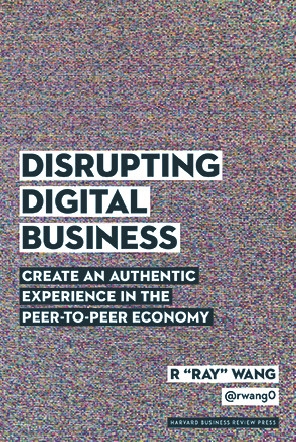Editor’s Note: Ray Wang, CEO of Constellation Research, just finished writing his new book, Disrupting Digital Business: Create an Authentic Experience in the Peer-to-Peer Economy. It’s a fascinating analysis of the powerful and disruptive changes in business — changes that touch every organization, every employee, and every person. We asked Ray a few questions about his research — his perspective is a wake-up call as the world approaches total connectivity.
Why should digital transformation be an urgent priority for companies in every industry?
Ray: A digital divide has emerged among global organizations. With 52% of the Fortune 500 either merged, acquired, gone bankrupt, or fallen off the list since 2000, almost all organizations in almost all industries are focused on identifying, testing, and executing on disruptive business models. Technology serves as an enabler, but the shift to digital business models is what’s creating this disruption in the marketplace.
You know, in most fields the top three companies have almost half of the market share, and up to three-quarters of the profits! Market leaders in this marketplace have built digital business models that have disrupted not only their industries, but adjacent industries. In fact, this digital Darwinism has been dire to those who wait.
How can a digital mindset help any company become a disruptor rather than the disrupted — the next Uber instead of the next Blockbuster?
Ray: The digital mindset starts by thinking not only outside the box, but by looking at how other industries and other models can be applied to one’s own space. What we traditionally view as innovation is almost an incremental process of continuous refinement until we reach a Eureka moment. The disruption required today is transformational innovation, which can have an impact on many business models at once. For example, we’ve identified that the iPhone has disrupted at least 27 business models. Products such as navigation devices, cameras, camcorders, music, personal digital assistants, film development, compasses, and even flashlights have faced the assault of such disruption.
To get to this mindset, organizations have to build a sort of digital DNA. This requires the promotion and support of digital artisans. Digital artisans can balance the science, technology, engineering, and math skills with the design aesthetic, anthropology, philosophy, and systems thinking required for business model design. In essence, this is right brain meets left brain. You want balance on the team in order to achieve this level of competency.
How have formerly old-line companies like Marriott and GE evolved with digital disruption and what benefits did they reap?
Ray: A great example at GE is how power and water have used great math and design to tackle the issue of power generation. The metric that matters most for them is uptime. They now have the ability to predict from 8 to 10 days when a power line is going to go down based on a number of factors such as temperature, wind speed, ground vibration, tensile strength, humidity, etc. This is a great example of how sensors and analytical ecosystems can help GE deliver on new business models and address complex industrial internet issues.
For Marriott, they’ve pioneered a customer experience culture through their Marriott Rewards program where the spirit to serve goes deep for Marriott Rewards members. This ability to create not only a consistent experience across all properties and brands, but also find ways to surprise and delight customers — and that’s key to building the advocacy required in a digital world.
In this digital, on-demand world, we no longer sell just product or services, we deliver on brand promises. This requires a focus on experiences, and outcomes.
Should investors be putting their money toward companies going digital and should they be wary of those who aren’t?
Ray: Investors should assess the digital DNA of the organizations they invest in. Without a digital mindset, few organizational leaders will be able to compete with digital disruptors. Of course, this must fall in line with the industry lifecycle as well as the competitive landscape. In general, if companies are not market leaders or fast followers they can expect their life as cautious adopters and laggards to lead to a slow death — or mergers and acquisitions.
What are networked economies and why will they be increasingly essential?
Ray: Individuals and organizations can influence the market massively on their own, but until they plug in to networked economies, they’re not going to realize their full potential. It’s happening right now. We’re just at the beginning of the chaos and the craziness of what will happen when we connect 75 billion or 80 billion devices by 2020. We’ll be seeing almost three billion people on social networks by 2020. This massive hyper-connectivity is driving what we predict to be somewhere between $70 trillion and$80 trillion in commerce by 2020.
Massive change is happening, and a lot of it is because everything we touch, everything we connect, everything we create results in digital exhaust. This digitalization of everything we touch changes the way we interact, because we can connect with a level of efficiency that we couldn’t before, and we can easily bypass any unnecessary friction. These networked economies are disintermediating, or cutting out the middleman, in every market they enter. We’re moving from experiences toward more personalized interactions than we’ve ever had before.
Why are the common customer relationship terms B2B and B2C giving way to a new model of P2P or People to People networks?
Ray: The world can no longer be defined as business-to-business (B2B) or business-to-consumer (B2C).
The power of digital has enabled a better P2P or people-to-people movement that eliminates middlemen and all the transaction costs that sit between you and a product/service or someone else. This P2P movement is driving the on-demand economy for services such as Task Rabbit, and for goods such as Etsy, and for businesses like Air BnB. P2P is happening as well in lending and payments. This is a growing trend because we are now dealing with individuals and the networks they belong to. That’s different from just servicing a single individual with no consequences.
And when that middleman and other barriers are taken away, you can connect with individuals who actually know what they’re doing and avoid a middleman. You can connect with systems that have better pricing information. This is the transformational power of digital that organizations can now unlock.
When we think of companies entering the digital space we typically think of them buying enterprise software and trying digital marketing. How much more extensive is a digital transformation as you’re seeing it?
Ray: Starting an organizational transformation with technology is a sure-fire way to lead to disaster. Success requires an organization to think first about what brand promise they want to make to their customers, how to adapt their business model to support this disruption, and then what technologies can get them there.
How can almost any company use digital technology to achieve “mass personalization” with their customer base and why is this such an enormous advancement?
Ray: The secret to mass personalization at scale requires organizations to track context. This context comes from a role, a relationship, a product, a process, the time of day, the location, the sentiment. We’re ultimately going after all the factors that can guestimate what an individual customer prefers and of course testing for when something changes in those preferences. In fact, why we don’t do something as predicted provides the best data points in order to understand personalization and this is where we expect machine learning and cognitive computing to play a role to serve customer segments of one.
When we hear buzzwords like “the Cloud” and “big data” are we missing the larger point of the full power of digital?
Ray: Definitely. The Cloud and big data provide powerful digital technologies but they are only enablers. The Cloud provides unlimited access to storage and computing power. Big data helps brings insights to bear and helps identify patterns we may not have discovered. The full power of digital, however, is far broader. First, it comes from creating a business model that provides an on-demand service at not only the lowest increment, but also enables bundles across many outcomes. Second, the full power of digital comes when we have direct-to-the-consumer or even people-to-people models that strip out the middleman and the friction of transaction costs. With a people-to-people model, people can go directly to each other with as little interference as possible.
Why can’t digital transformation be outsourced or delegated to a programming team or department?
Ray: Digital transformation has to come from within the company. This is a business model, and a cultural, and technology shift. There’s no way to outsource that.
While digital may be applied as an adjective to every movement or trend, I define digital transformation as the methodology in which organizations transform and create new business models and culture with digital technologies.
“Digital Transformation is the methodology in which organizations transform and create new business models and culture with digital technologies.”
To elaborate, transformation arises when organizations apply a design mindset to craft new experiences and outcomes. As organizations move from selling products and services to keeping brand promises, the digital era requires a high degree of trust and transparency that supports and augments brand authenticity. Digital technologies provide rich data sets which can be analyzed to surface up patterns of insight. That insight enables organizations to easily deliver on mass personalization at scale (i.e. segment of one) by improving contextual relevancy. Contextual relevancy (i.e. right time relevancy) built on roles, relationships, business process, location, time, and sentiment provide a foundation to create intention driven experiences and outcomes.
Success in digital transformation requires organizations to build a culture that supports a digital DNA and development of digital artisans who can navigate between the right brain and left brain world. The result is the organization’s capacity to create new business models or augment existing business models that disrupt the status quo; and sense and respond in real-time to market shifts.
So, how can a company use digital technology to shift their business model to better deliver on its brand promise?
Ray: A quick way is to identify how data can be captured, refined, and used. Data is the foundation of digital businesses. By identifying patterns in data, you can find new opportunities and then test how they meet your brand promise. For example, large medical device companies such as GE and Siemens now sell uptime of their products instead of just selling the product. Uptime is a measure of the time a machine, typically a computer, has been working and available. So they used to sell a $1M device, and then would upsell financing, and then upsell support and service. Now they just offer 80% uptime for $3.5M and 95% uptime for 4.5M.
I think it must be more than technology alone that will lead to digital disruption? What else is needed for organizations to advance as a digital business?
Ray: Technology is not enough. In fact, the human factor is key to success. We need to transform an organization’s culture to support a digital DNA. We need to build natural incentives through gamification and through transparent value exchange. In many cases, monetary rewards are not enough. Recognition, access, and impact go a long way as non-monetary incentives that can drive cultural transformation.
What are the first steps we can take today toward achieving digital transformation at our own businesses or organizations?
Ray: Start by thinking about what brand promises you want to make to your customer, how you could adapt your business model to better achieve them, and then which technologies can help you do so. From there, figure out how to apply data to the decision making, and then open up the platform for others to co-innovate and co-create on with you.


